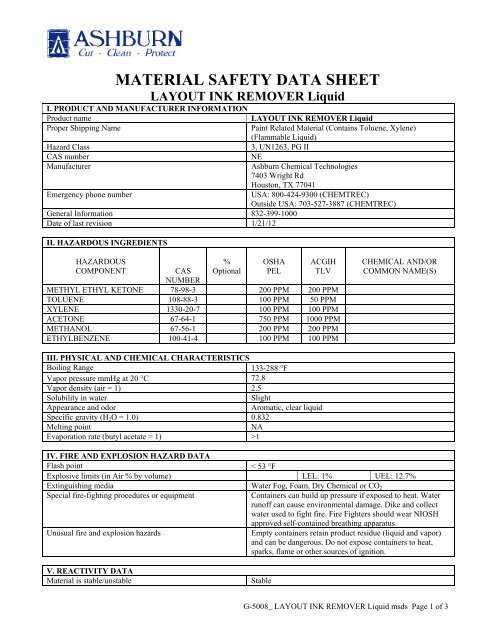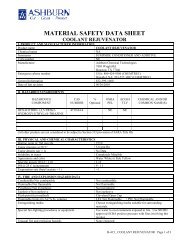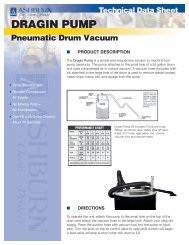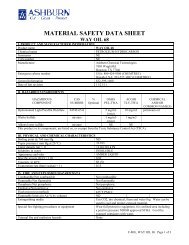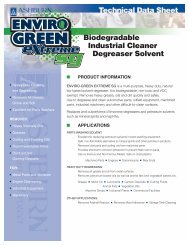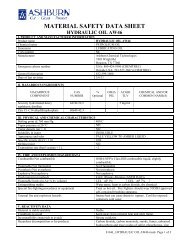MSDS Liquid - Ashburn Chemical Technologies
MSDS Liquid - Ashburn Chemical Technologies
MSDS Liquid - Ashburn Chemical Technologies
Create successful ePaper yourself
Turn your PDF publications into a flip-book with our unique Google optimized e-Paper software.
MATERIAL SAFETY DATA SHEET<br />
LAYOUT INK REMOVER <strong>Liquid</strong><br />
I. PRODUCT AND MANUFACTURER INFORMATION<br />
Product name<br />
LAYOUT INK REMOVER <strong>Liquid</strong><br />
Proper Shipping Name<br />
Paint Related Material (Contains Toluene, Xylene)<br />
(Flammable <strong>Liquid</strong>)<br />
Hazard Class<br />
3, UN1263, PG II<br />
CAS number<br />
NE<br />
Manufacturer<br />
<strong>Ashburn</strong> <strong>Chemical</strong> <strong>Technologies</strong><br />
7403 Wright Rd<br />
Houston, TX 77041<br />
Emergency phone number<br />
General Information 832-399-1000<br />
Date of last revision 1/21/12<br />
II. HAZARDOUS INGREDIENTS<br />
USA: 800-424-9300 (CHEMTREC)<br />
Outside USA: 703-527-3887 (CHEMTREC)<br />
HAZARDOUS<br />
COMPONENT<br />
%<br />
Optional<br />
OSHA<br />
PEL<br />
ACGIH<br />
TLV<br />
CAS<br />
NUMBER<br />
METHYL ETHYL KETONE 78-98-3 200 PPM 200 PPM<br />
TOLUENE 108-88-3 100 PPM 50 PPM<br />
XYLENE 1330-20-7 100 PPM 100 PPM<br />
ACETONE 67-64-1 750 PPM 1000 PPM<br />
METHANOL 67-56-1 200 PPM 200 PPM<br />
ETHYLBENZENE 100-41-4 100 PPM 100 PPM<br />
CHEMICAL AND/OR<br />
COMMON NAME(S)<br />
III. PHYSICAL AND CHEMICAL CHARACTERISTICS<br />
Boiling Range 133-288 °F<br />
Vapor pressure mmHg at 20 °C 72.8<br />
Vapor density (air = 1) 2.5<br />
Solubility in water<br />
Slight<br />
Appearance and odor<br />
Aromatic, clear liquid<br />
Specific gravity (H 2 O = 1.0) 0.832<br />
Melting point<br />
NA<br />
Evaporation rate (butyl acetate = 1) >1<br />
IV. FIRE AND EXPLOSION HAZARD DATA<br />
Flash point < 53 °F<br />
Explosive limits (in Air % by volume) LEL: 1% UEL: 12.7%<br />
Extinguishing media Water Fog, Foam, Dry <strong>Chemical</strong> or CO 2<br />
Special fire-fighting procedures or equipment<br />
Containers can build up pressure if exposed to heat. Water<br />
runoff can cause environmental damage. Dike and collect<br />
water used to fight fire. Fire Fighters should wear NIOSH<br />
approved self-contained breathing apparatus<br />
Unusual fire and explosion hazards<br />
Empty containers retain product residue (liquid and vapor)<br />
and can be dangerous. Do not expose containers to heat,<br />
sparks, flame or other sources of ignition.<br />
V. REACTIVITY DATA<br />
Material is stable/unstable<br />
Stable<br />
G-5008_ LAYOUT INK REMOVER <strong>Liquid</strong> msds Page 1 of 3
Conditions to avoid<br />
Incompatibility (materials to avoid)<br />
Hazardous decomposition or by-products<br />
Hazardous polymerization will/will not occur<br />
Do not store above 120 °F. Keep away from sparks and/or<br />
open flames.<br />
Avoid contact with oxidizers<br />
Thermal decomposition may form Carbon Monoxide and/or<br />
Carbon Dioxide<br />
Will not occur.<br />
VI. HEALTH HAZARD DATA<br />
**Emergency Overview** May be harmful or fatal if swallowed or inhaled.<br />
Threshold Limit Value<br />
TLV for this product not established. Refer to the hazardous materials list<br />
for TLV of individual ingredients.<br />
Primary route(s) of entry<br />
Inhalation, Skin Contact, Ingestion, Eye Contact<br />
Known Hazards Under 29 CFR 1910.1200<br />
Mutagenic (genetic defects)<br />
Reproductive<br />
Systemic<br />
Teratogenic (birth defects)<br />
Carcinogen listed in:<br />
NTP (National Toxicology Program)<br />
IARC Monographs<br />
OSHA<br />
Signs and symptoms of exposure<br />
Inhalation<br />
Skin contact<br />
Eye contact<br />
Ingestion<br />
Emergency first aid procedures<br />
Inhalation<br />
Skin contact<br />
Eye contact<br />
Ingestion<br />
Medical conditions generally aggravated by<br />
exposure<br />
Effects of Overexposure<br />
NONE<br />
NONE<br />
NONE<br />
NONE<br />
NO<br />
NO<br />
NO<br />
Harmful if inhaled. May affect the brain or nervous system causing<br />
dizziness, headache, or nausea. Excessive exposure may cause changes in<br />
heart rate and/or irritation to respiratory tract.<br />
Prolonged or repeated contact may cause skin irritation, drying or rash.<br />
Causes eye irritation. <strong>Liquid</strong>, aerosol and vapors are irritating and can cause<br />
pain, tearing, reddening, and swelling accompanied by a stinging sensation.<br />
Material may be harmful or fatal if swallowed<br />
Remove to fresh air. If not breathing, give artificial respiration. Call<br />
physician immediately.<br />
Wash off thoroughly with soap and water. Remove contaminated clothing<br />
and launder before re-use. Discard contaminated leather gloves and shoes.<br />
Flush with water for 15 minutes. Seek medical attention if irritation persists.<br />
Seek medical attention immediately.<br />
Persons with pre-existing skin disorders should avoid contact with this<br />
product.<br />
Chronic hazards. Reports have associated repeated and prolonged<br />
overexposure to solvents with permanent brain damage and nervous system<br />
damage. Intentional misuse by deliberately concentrating and inhaling the<br />
contents may be harmful or fatal.<br />
VII. PRECAUTIONS FOR SAFE HANDLING AND USE<br />
Steps to take if released or spilled<br />
Absorb with inert material (i.e. dry sand or earth), and then transfer to<br />
properly labeled chemical waste container.<br />
Waste disposal method<br />
Use approved treatment, transporters and disposal sites in accordance with<br />
local, state and federal laws. Do not flush to storm or sanitary sewer.<br />
Precautions for handling and storing Do not expose to heat or store at temperatures above 120°F. Launder<br />
contaminated clothing before reuse. Use as directed. Normal precautions<br />
common to good manufacturing should be followed in storage and handling.<br />
G-5008_ LAYOUT INK REMOVER <strong>Liquid</strong> msds Page 2 of 3
Other precautions<br />
For industrial use only. Affix warning labels on containers in accordance<br />
with 29 CFR 1910.1200<br />
Hazard ratings NFPA HMIS<br />
Health 3 3<br />
Flammability 4 4<br />
Reactivity 1 1<br />
Personal protection<br />
B<br />
VIII. CONTROL MEASURES<br />
Protective gloves (type and material)<br />
Eye protection<br />
Other protective clothing or equipment<br />
Respiratory protection (specify type)<br />
Ventilation and conditions<br />
Local<br />
Mechanical<br />
Other<br />
Work/hygienic practices<br />
Use chemical-resistant gloves in situations of overexposure.<br />
Wear safety glasses or goggles.<br />
Use approved bonding and grounding procedures.<br />
Use only with adequate ventilation. Use NIOSH approved respirator with<br />
organic vapor cartridge when airborne concentrations are expected to exceed<br />
exposure limits.<br />
Yes<br />
Recommended to control airborne levels to below the exposure guidelines.<br />
Lethal concentrations may exist in areas with poor ventilation. Use<br />
explosion-proof ventilation equipment.<br />
None<br />
Do not wear contaminated clothing. Wash hands prior to eating, drinking,<br />
smoking or use of restroom and when leaving work.<br />
IX. ADDITIONAL REGULATORY INFORMATION<br />
SARA hazard category (Section 311 and<br />
312 of the Superfund Amendment and<br />
Reauthorization Act of 1986 (SARA Title<br />
III)<br />
Toxic chemical(s) subject to the supplier<br />
notification requirements of section 313 of<br />
the Superfund Amendment and<br />
Reauthorization Act of 1986 (SARA) and<br />
the requirements of 40 CFR part 372<br />
Ingredient(s) regulated under the Clean Air<br />
Act Section 112 hazardous air pollutants<br />
and subject to all reporting requirements of<br />
CERCLA (Superfund)<br />
California Proposition 65: The following<br />
statement is made in order to comply with<br />
the California Safe Drinking Water and<br />
Toxic Enforcement Act of 1986:<br />
Immediate (acute) health hazard, delayed (chronic) health hazard,<br />
Fire Hazard<br />
Methyl Ethyl Ketone (78-93-3), Toluene (108-88-3), Xylene (1330-20-7),<br />
Methanol (67-56-1), Ethylbenzene (100-41-4)<br />
None<br />
The following chemicals contained in this product are known to the state of<br />
California to cause birth defects or other reproductive harm: Toluene (108-<br />
88-3), Ethylbenzene (100-41-4)<br />
NA – not applicable NR – not reported ND – not determined NE – not established UN – unknown<br />
The information presented in this <strong>MSDS</strong> has been compiled from sources deemed reliable. This <strong>MSDS</strong> is presented in good<br />
faith and believed to be accurate as of the effective date shown above. No warranty, expressed or implied, is given.<br />
Regulatory requirements are subject to change and may differ from one location to another. It is the responsibility of the<br />
buyer to insure compliance with federal, state, provincial and local laws and regulations.<br />
G-5008_ LAYOUT INK REMOVER <strong>Liquid</strong> msds Page 3 of 3


